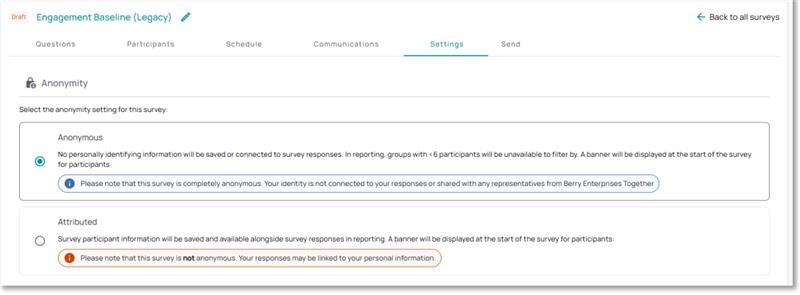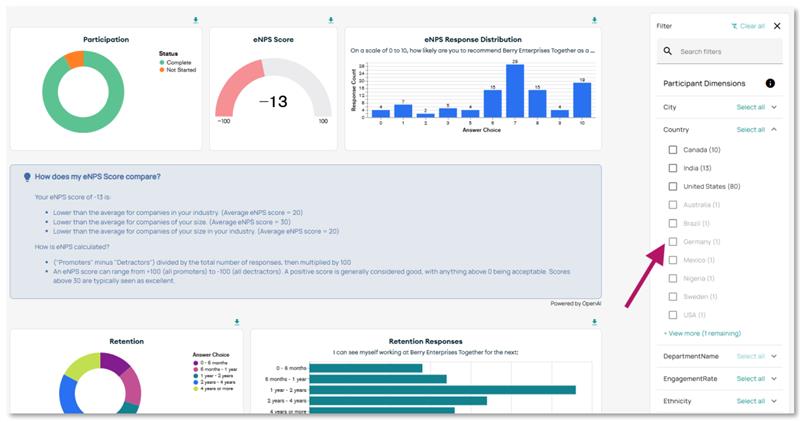August 22, 2025

When it comes to employee surveys, anonymity isn’t just a nice-to-have—it’s essential. Protecting employee privacy ensures that feedback is honest, candid, and truly useful for shaping workplace culture.
Without strong anonymity measures, employees may hesitate to share their real thoughts, undermining the purpose of gathering feedback in the first place.
Here are 3 ways that Terryberry's survey platform safeguards employee anonymity at every step of the survey experience.
1. Control Who Can Access Surveys
The first step in protecting employee privacy is limiting access to survey data: from the participants’ personal identification to the final survey results.
Our permission-based system only allows specific roles—like Admins and Managers —to view survey results. This prevents unauthorized individuals from accessing sensitive employee feedback, ensuring data security from the start.
Additionally, a minimum of six participants is required to view a group’s survey results at all, which prevents the viewer from identifying individuals based on their responses. This means if a group does not have at least 6 participants respond, you will not be able to see that group’s scores when trying to view by that particular demographic.
For example: if Engineering only had 4 people respond to a question, you wouldn’t be able to see the scores for that question by the Engineering department. However, their scores are still rolled into the aggregate of the overall score.
2. Choose the Right Survey Type

Not all surveys are created equal. That’s why we created anonymous and attributed survey types, which determine how we handle your survey data:
- Attributed Surveys
These are best for smaller, focused use cases like onboarding surveys, where individual follow-up is valuable. Responses remain tied to participants’ information throughout the process.
- Anonymous Surveys
This type of survey is designed to encourage honest, unbiased feedback by completely protecting participant identities. Safeguards for this type of survey in Terryberry’s survey platform include:
- A minimum of six participants to prevent singling out individuals.
- Locked results until the survey closes, ensuring partial data isn’t exposed.
- Permanent deletion of identifiable data after completion.
- Minimum results display—no filters or results are shown with fewer than six responses.
These rules ensure employees can confidently share their experiences without fear of being identified.

3. Protected Anonymity Through Question Design
Even the best anonymity settings can be undermined by poorly designed questions. That’s why question wording, scope, and combinations matter.
- Use Templates for Sensitive Topics
Terryberry’s pre-written survey templates are designed with research-backed language and tested combinations to protect anonymity while still capturing meaningful insights. These are ideal for employee engagement, leadership feedback, and culture surveys.
- Use Custom Surveys for Practical Needs
Custom surveys work best for straightforward, low-risk topics such as:
- Event planning (meal preferences, T-shirt sizes)
- Team culture (holiday traditions, office events)
- Program feedback (training sessions, policy changes)
- Operational input (workspace improvements, meeting times)
By reserving templates for sensitive feedback and custom surveys for logistics, organizations get the best of both worlds—rich insights without risking employee trust.
Building a Culture of Trust
At the heart of every successful survey program is trust. When employees know their privacy is protected, they feel empowered to be open and honest. That authenticity is what drives actionable insights and, ultimately, meaningful improvements in workplace culture.
By combining secure access controls, thoughtful survey selection, and smart question design, organizations can ensure employees’ privacy and anonymity are never compromised. This helps pave the way for HR teams to utilize employee feedback in their strategies for creating a culture of engaged, motivated, and satisfied employees.
